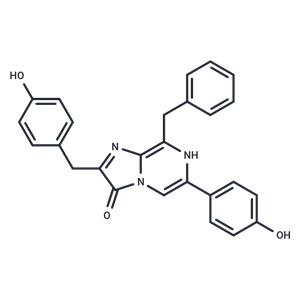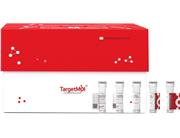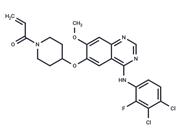| Name | Coelenterazine |
| Description | Coelenterazine is a superoxide anion-sensitive chemiluminescent probe that can be used to detect the chemiluminescence of peroxynitrite and can serve as a luminescent enzyme substrate for apoaequorin and Renilla luciferase. |
| Cell Research | Cells are plated at a density of 5×10^4?cells per well into 24-well plates and grown to 80-100% confluency. Just before imaging, media are changed to a colorless solution containing (in mM): 2.7 KCl, 139 NaCl, 8.1 Na2HPO4, 0.7 H2O, 1.5 KH2PO4, 1.8 CaCl2, 1 MgCl2?and 5.5 d-glucose. Cells are preincubated for 15 min in the absence or presence of Pgp modulator, after which Coelenterazine (final concentration of 470 nM) is added directly to the cells. They are for reference only. |
| Animal Research | Mice are anesthetized with metofane or isoflurane before tail vein injection of Coelenterazine (4 μg/g) formulated from an ethanol stock diluted in sodium phosphate buffer (50 mM). Bioluminescence imaging is performed on the in vivo imaging system at 2, 6, 8, and 11 min after injection. Anesthesia is maintained during imaging by nose cone delivery of 2.5% isoflurane. After imaging, animals are killed by cervical dislocation; tumors are then harvested and weighed. They are for reference only. |
| In vitro | When monitoring various biological processes, coelenterazine (CTZ) can be catalyzed by luciferases, such as the sea pansy Renilla reniformis (Rluc) and the marine copepod Gaussia princeps (Gluc), which results in emission of blue light. In Gli36-Gluc- or Gli36-Rluc-expressing Gli36 cells, coelenterazine (8 礸/ml) shows a bioluminescence signal. [1] In RIN-5F, 4T1, HCT 116, HEK 293, 293FT, HeLa and INS-1 cells, coelenterazine can be used to assay superoxide anion concentrations. [2] |
| In vivo | METHODS: Gli36-Gluc and Gli36-Rluc cells were injected into the leg muscles of nude mice. Mice were injected intravenously with 100 μg (4 mg/kg body weight) of coelenterazine and immediately imaged using a cooled charge-coupled device (CCD) camera. The mice were injected with 500 μg (20 mg/kg) of water-soluble coelenterazine and imaged using a CCD camera.
RESULTS Water-soluble coelenterazine produced 10-fold higher photon counts for Gluc and 4-fold higher photon counts for Rluc, indicating that s-coelenterazine is more sensitive for detecting coelenteric acid luciferase in vivo. [1] |
| Storage | keep away from direct sunlight | Powder: -20°C for 3 years | In solvent: -80°C for 1 year | Shipping with blue ice. |
| Solubility Information | Ethanol : 1 mg/mL (2.36 mM), DMSO inactivates the activity of Coelenterazine.
H2O : < 1 mg/mL (insoluble or slightly soluble)
|
| Keywords | inhibit | Inhibitor | Coelenterazine |

 United States
United States



